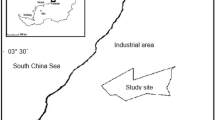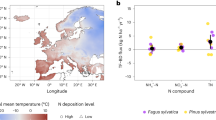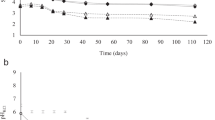Abstract
Acid rain commonly has high concentrations of dissolved SO2−4, NH+4 and NO−3. Sulphuric and nitric acids are usually considered to be the acidic components, whereas ammonium has a tendency to increase the pH of rainwater1. Ammonium can be transformed to nitric acid in soil but this source of acidity is generally less important than wet and dry deposition of free acids2,3. Here we describe the occurrence of high concentrations of ammonium in canopy throughfall (rainwater falling through the tree canopy) and stemflow in woodland areas in the Netherlands, resulting in acid inputs to soils two to five times higher than those previously described for acid atmospheric deposition2–5. The ammonium is present as ammonium sulphate, which probably forms by interaction of ammonia (volatilized from manure) with sulphur dioxide (from fossil fuels), on the surfaces of vegetation. After leaching by rainwater the ammonium sulphate reaching the soil oxidizes rapidly to nitric and sulphuric acid, producing extremely low pH values (2.8–3.5) and high concentrations of dissolved aluminium in the non-calcareous soils studied. Deposition of ammonium sulphate on the surfaces of vegetation and its environmental consequences are probably most important in areas with intensive animal husbandry.
This is a preview of subscription content, access via your institution
Access options
Subscribe to this journal
Receive 51 print issues and online access
$199.00 per year
only $3.90 per issue
Buy this article
- Purchase on Springer Link
- Instant access to full article PDF
Prices may be subject to local taxes which are calculated during checkout
Similar content being viewed by others
References
Charlson, R. J. & Rohde, H. Nature 295, 683–685 (1982).
Hutchinson, T. C. & Havas, M. (eds) Effects of Acid Precipitation on Terrestrial Ecosystems (Plenum, New York, 1980).
Drabløs, D. & Tollan, A. (eds) Ecological Impact of Acid Precipitation (SNSF project, Ås, Norway, 1980).
Glass, G. E., Brydges, T. G. & Loucks, O. L. Impact Assessment of Airborne Acidic Deposition on the Aquatic Environment of the United States and Canada (US Environmental Protection Agency, 1981).
Ulrich, B., Mayer, R. & Khanna, P. K. Deposition von Luftverunreinigungen und ihre Auswirkungen in Waldökosystemen in Soiling (Sauerlander, Frankfurt a.M., 1979).
Begheijn, L. Th. Methods of Chemical Analyses for Soils and Waters (Agricultural University, Wageningen, The Netherlands, 1980).
Okita, T. & Kanamori, S. Atmos. Envir. 5, 621–627 (1971).
Romell, L. G. Svensk bot. Tidskr. 40, 1–8 (1946).
Meetnet voor de Bepaling van de Chemische Samenstelling van de Neerslag, Jaaroverzicht, 1980, (KNMI, De Bilt, The Netherlands 1981).
Eaton, J. S., Likens, G. E. & Bormann, F. H. J. Ecol. 61, 495–408 (1973).
Richter, A. & Granat, L. Int. met. Inst. Rep. AC-43 (Stockholm, 1978).
Rippon, J. E., Skeffington, R. E., Wood, M. J., Brown, K. A. & Brown, D. J. A. in Ecological Impact of Acid Precipitation (eds Drabløs, D. & Tollan, A.) 276–277 (SNSF Project, Ås, Norway, 1980).
Lauer, D. A., Bouldin, D. R. & Klausner, S. D. J. envir. Qual. 5, 134–141 (1976).
Brogan, J. C. (ed.) Developments in Plant and Soil Sciences Vol. 2 (Nijhoff/Junk, The Hague, 1981).
Hoeft, R. G., Keeney, D. R. & Walsh, L. M. J. envir. Qual. 1, 203–208 (1972).
Tjepkema, J. D., Cartica, R. J. & Hemond, H. F. Nature 294, 445–446 (1981).
Brosset, C. Atmos. Envir. 12, 25–38 (1978).
Hegg, D. A. & Hobbs, P. V. Atmos. Envir. 12, 241 (1978).
Porter, L. K., Viets, F. G. & Hutchinson, G. L. Science 175, 759–761 (1972).
Bjor, K. & Teigen, O. in Ecological Impact of Acid Precipitation (eds Drabløs, D. & Tollan, A.) 200–201 (SNSF project, Ås, Norway, 1980).
Prenzel, J. Pl. Soil 51, 39–49 (1979).
Matzner, E. & Hetsch, W. Z. Pfl-Ernähr. Düng. Bodenk. 144, 64–73 (1981).
Cronan, C. S. & Schofield, C. L. Science 204, 304–305 (1979).
Overrein, L. N., Seip, H. M. & Tollan, A. Acid Precipitation Effects on Forest and Fish (SNSF project, Ås, Norway, 1980).
Likens, G. E., Bormann, F. H., Pierce, R. S., Eaton, J. S. & Johnson, N. M. Biogeochemistry of a Forested Ecosystem (Springer, New York, 1977).
Hutchinson, G. L. & Viets, F. G. Jr Science 166, 514–515 (1969).
Author information
Authors and Affiliations
Rights and permissions
About this article
Cite this article
van Breemen, N., Burrough, P., Velthorst, E. et al. Soil acidification from atmospheric ammonium sulphate in forest canopy throughfall. Nature 299, 548–550 (1982). https://doi.org/10.1038/299548a0
Received:
Accepted:
Issue Date:
DOI: https://doi.org/10.1038/299548a0
This article is cited by
-
Wet depositions of cations in forests across NADP, EMEP, and EANET monitoring networks over the last two decades
Environmental Science and Pollution Research (2022)
-
Assessing the costs and environmental benefits of IMO regulations of ship-originated SOx and NOx emissions in the Baltic Sea
Ambio (2021)
-
Spatio-temporal distribution of reactive nitrogen species in relation to wheat cultivation in Bangladesh
SN Applied Sciences (2021)
-
Using golden apple snail to mitigate its invasion and improve soil quality: a biocontrol approach
Environmental Science and Pollution Research (2020)
-
What is the potential of silver fir to thrive under warmer and drier climate?
European Journal of Forest Research (2019)
Comments
By submitting a comment you agree to abide by our Terms and Community Guidelines. If you find something abusive or that does not comply with our terms or guidelines please flag it as inappropriate.



